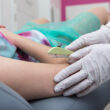Have you ever had that moment—perhaps right after losing your temper on an innocent friend or while crying during a rom com—when suddenly the light bulb goes off? Ah, I’m about to start my period. Why is it that our emotions can shift so much in those days right before menstruation, often coupled with physical symptoms like bloating or headaches? For many women, the challenging symptoms right before their next period starts are caused by Premenstrual Syndrome, or PMS. And for teen girls in their first few years of experiencing periods, there can be unique challenges in dealing with these issues.
While mild versions of PMS affect around 75% of women with regular cycles, there is also a less common disorder that a small subset of these women experience. This is called premenstrual dysphoric disorder (PMDD) and 3-8% of cycling women have it. Unfortunately, PMDD typically lasts over the course of a lifetime and is listed as a distinct medical disorder in the 5th edition of the American Psychiatric Association’s Diagnostic and Statistical Manual of Mental Disorders (DSM-5). While PMS and PMDD do have similarities, there are differences in how they manifest.
While we’ve previously addressed PMS and PMDD in general, here we’ll be looking specifically at how they affect teen girls, and why some of the most commonly prescribed treatments aren’t necessarily best for teenage girls.
Teens might have PMS or PMDD if…
While many people know the classic symptoms of PMS—bloating, irritability, crying spells, breast tenderness, headaches, and fatigue—PMDD is a much more severe disorder that can cause the sufferer to experience intense depressive episodes before her period. PMDD symptoms include severe anxiety, feeling on edge, hopelessness, frequent crying, trouble concentrating, excessive sleeping or difficulty sleeping, and feeling overwhelmed or out of control.
Teens with PMDD may suffer symptoms two weeks out of every month
These symptoms go beyond the mood swings that the 75% of women with PMS experience, and they can last from right after ovulation until the beginning of your period. This means that, for women with PMDD, two weeks out of every menstrual cycle can sometimes be affected by these psychiatric symptoms. Assuming a stereotypical 28-day cycle, that’s almost 50% of each month!
Intense PMDD symptoms may take teens completely by surprise
There isn’t really any difference in how teenagers experience either PMS or PMDD vs how adult women experience them, but the sudden onset of these symptoms in young girls just beginning their cycles can be jarring. A teenager experiencing PMDD might find it difficult to get ready for school in the morning and feel a sense of dread at the prospect of doing activities that she might otherwise love to do. She might forget to eat lunch, have frequent crying spells, and have difficulty concentrating during class.
PMDD vs clinical depression in teens
The difference between a teenager experiencing PMDD and one with clinical depression is that these symptoms would only be present during the second half of her cycle (from after ovulation until the beginning of the next period) for a girl with PMDD, whereas someone with clinical depression has depressive episodes no matter where she is in her cycle. While anxiety or depression could worsen with PMDD, a girl only experiencing mental health issues during her luteal phase (the second half of her cycle) most likely does not also have a separate anxiety or depression disorder.
Even though rates of PMDD are low for women of all ages (and about 5% for teenagers, specifically), rates of “moderate-to-severe premenstrual symptoms associated with functional impairment” are around 20% for teens, according to research [1]. This means that although it’s not common for teens and young women to experience the severe, life-altering effects of PMDD, around one in five are experiencing PMS symptoms drastic enough to impair their ability to go about their daily life.
What causes PMS and PMDD in teens and how do you know if you’re experiencing one or the other?
Unfortunately, the exact causes of PMS and PMDD are not known, but researchers often cite hypersensitivity to the normal hormonal changes you have during the luteal phase. There’s not a way to definitively test for either PMS or PMDD, but your doctor might recommend a blood test to rule out other potential issues like hypo- or hyperthyroidism.
What should teens do if they think they have PMDD?
If you think you might be experiencing the more severe symptoms of PMDD rather than the milder PMS, the first step is to begin taking a detailed log of your symptoms. You can use either a period tracking app with the ability to add notes, or simply write in a paper journal. Mark the first day of your period with the date, then write down how you’re feeling—continuing this until the end of your cycle comes and you begin another period.
Do you have any physical symptoms like bloating, headaches, breast tenderness, acne, or fatigue? Are you experiencing any of the psychological symptoms listed above, especially intense anxiety or depression? Try to be as detailed as you can in logging any symptoms. Once you have a journal of how your cycle went, take this to your next doctor’s appointment.
Can PMS or PMDD be treated?
Once you meet with your doctor to discuss your symptoms, he or she may request you first try some lifestyle changes before talking about more drastic solutions. There is data to suggest that certain supplements like calcium may help in reducing PMS symptoms, and there are many other natural remedies which can be used to ease PMS [1]. In addition, eating a healthy diet and incorporating regular exercise into your week will both have the biggest impact on your health outcomes. Exercise is specifically proven to reduce stress, which can help if you’re experiencing some of the psychological symptoms of PMDD.
Two other common solutions are reducing your caffeine intake or seeking out cognitive behavioral therapy to help with the mental health effects of PMS or PMDD.
Are antidepressants safe for teen girls with PMDD?
Beyond lifestyle shifts, the most common solutions given to women with PMDD (typically PMS is not met with a prescription due to the ‘normalcy’ of the syndrome) are either antidepressants or hormonal birth control. Antidepressants include brand names like Zoloft, Lexapro, or Prozac. These are common prescriptions for sufferers of PMDD, as they are experiencing clinical levels of depression or anxiety during the premenstrual portion of their cycle.
However, antidepressants are not necessarily the safest option for teen girls who are experiencing PMDD, as they carry a black box warning from the US Food and Drug Administration (FDA). A black box warning from the FDA means that the drug necessitates the most stringent warning about serious side effects. For antidepressants, there is a black box warning of increased suicidal thinking or behavior for people under the age of 25 who use these drugs.
Does the black box warning mean teens with PMDD should never take antidepressants?
This warning does not mean that it is always unsafe for a person under 25 to be put on antidepressants. Not every girl will experience side effects. Nonetheless, it is crucial for parents of teens with PMDD to weigh the pros and cons of putting their daughters on these drugs. And if parents do choose to put their daughter on an antidepressant to help with her PMDD, it is vital to keep a close eye on her to identify warning signs.
What about hormonal birth control for PMDD symptoms?
The other common prescription your doctor might give for PMDD is hormonal birth control. By taking most forms of the birth control pill, your period will be suppressed. This can sometimes relieve the symptoms of PMS or PMDD. However, there are many teen girls and women who find that taking birth control actually makes their PMS or PMDD symptoms worse. Birth control pills were not created for the purpose of alleviating premenstrual disorders, so while they might have that effect for some women, they are not a certain “cure” for symptoms. On top of that, introducing hormonal birth control into your body brings with it a whole host of risks and side effects, and girls who start using hormonal birth control as teens are at an elevated risk for developing clinical depression in adulthood–even after discontinuing birth control use.
The role fertility awareness can play in PMS or PMDD treatment
Unfortunately, there is no definitive cure for either PMS or PMDD. A combination of lifestyle changes like a healthy diet, exercise, and seeking out therapy could be very helpful in reducing the symptoms that you’re experiencing. The first step, however, is taking ownership of your cycle by keeping a careful log of the symptoms you’re experiencing. Once you start to notice the way your body responds to the different phases of your cycle, you can also begin to track other bodily signs to know when you are ovulating and when you are approaching your period. This is known as charting your cycle, a practice that is useful even before you’re sexually active.
By learning to chart your cycle and recording not only your fertile signs but also your PMS/PMDD symptoms, you can feel more in control of the peaks and valleys of your monthly rhythms. Though cycle charting will also not cure the symptoms of PMS or PMDD, knowing that you are getting close to the days when you typically experience depression or anxiety can help you mentally and physically prepare for what lies ahead. You could plan your social calendar around these days, get ahead on schoolwork before your concentration dips, or prepare a day of authentic self care right before your period. By having more knowledge about your cycle and understanding the causes behind your PMS or PMDD, you’ll be able to more confidently take on the challenges of your cycle.
References:
[1] Rapkin, Andrea J, and Judith A Mikacich. “Premenstrual dysphoric disorder and severe premenstrual syndrome in adolescents.” Paediatric drugs vol. 15,3 (2013): 191-202. doi:10.1007/s40272-013-0018-4







Charting your cycles with the Creighton Model FertilityCare System can also bring relief of the PMS/PMDD symptoms when combined with a NaProTechnology Medical Consultant. They know how to test your hormones on very specific days as relates to your Creighton Model charting.